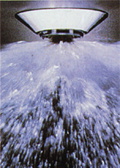Yes, It’s True: They’re on the Way.
It’s been talked about for decades: residential fire sprinklers. I have known of only one municipality that actually required it before now, and that was in Altamonte Springs, Florida. Well, it’s going to be a whole new ball game soon. The ICC’s (International Code Council) April 15, 2010 press release explicitly states that their 2009 IRC (International Residential Code) requires this.

YES, WE ARE TALKING ABOUT FIRE SPRINKLERS FOR HOUSES. We are not talking about irrigation sprinklers outside of your new house. No. The IRC is requiring that the Interior of new homes have fire sprinklers. A friend of ours and fellow architect, Nazim Nice, with Motion Space Architecture, has speculated that the added cost to home construction may be between $0.80/sf (square foot) to as much as $4/sf. The actual cost, of course, will depend on what the actual fire sprinkler subcontractor who works for your general contractor decides to price your system at. Also, Nazim Nice’s original post on this subject has served as our inspiration.
Time Frame
The ICC has indicated that: “approved fire sprinkler systems will be required in all one- and two-family dwellings constructed after the 2009 IRC is adopted (by your jurisdiction) or on January 1, 2011, whichever is later.”
Comments and Discussion with Allied Fire Protection Systems, Inc.
On 5/3/2010, Rand Soellner AIA had a conversation with Charles (Chuck) S. Lynn, President of Allied Fire Protection Systems, Inc. (1-716-665-6517 in Falconer, NY), a substantial provider of fire protection systems in that area of our Country. Allied has fire protection systems in everything from nuclear plants to single family homes in the entire NorthEast quarter of the USA. Rand and Chuck discussed the implications of Chuck’s question: “Where does the water come from?” That is a darn good question. Rand theorized that, due to the bacteriological implications of standing water inside pipes, there could possibly end up being a requirement for a second connection to potable water sources, with a small residential-scale back flow preventer, to reduce the possibility of contaminating the potable water supply line. There was some additional discussion about certification and training sources. Chuck Lynn said that he knew of several jurisdictions that have had residential fire sprinklers for over 10 years or more.
Who Can Install These New Residential Systems
There are many commercial fire sprinkler contractors in the United States, but not many residential fire sprinkler subcontractors. No doubt this code news will create a flood of commercial fire sprinkler companies diversifying into the residential market and perhaps for residential plumbers obtaining the necessary certifications to allow them to legally install residential fire sprinkler systems. The ICC has a Residential Fire Sprinkler Design and Installation Exam that providers of the systems must pass.
The Reason for Residential Fire Sprinklers
The ICC cites that 3,000+ people a year in the United States die in fires, and that 84% of these deaths occur in their own homes. Even though smoke alarms help alert home owners to the threat of fire and smoke, ceiling-mounted residential fire sprinklers can put out fires while they are still small, which helps control or stop heat, flames and deadly smoke. Property and lives are saved. The purpose of requiring the new residential fire sprinklers is to help save lives and property.
Accrediting Agencies
CPSE (the Center for Public Safety Excellence), ICC (International Code Council), and NFSA (National Fire Sprinkler Association) have signed a joint resolution creating a new Commission for the Accreditation for Dwelling Fire Sprinkler Contractors.
Related Issues
One of the first thoughts I had about this for our clients who have vacation or primary residences in scenic locations with wells as their source of water means that the amount of water required for a fire suppression event will likely exceed the capacity in GPM (Gallons Per Minute) that any normal pump can draw from a subterranean aquifer source. Also, what if the well has gone dry? Even temporarily? So, it is our belief that it will probably become necessary for large water storage tanks, buried (or otherwise earth-covered to avoid freezing) as part of the system. We also happen to know that water is alive; it has microbes, so any standing water will need to be periodically flushed and replenished to avoid putrid standing water from being what happens to be pumped into your home to put out a fire. So, there will need for periodic maintenance and checking of system components. In more urban areas where there is adequate water pressure and flow to support these new residential fire sprinkler requirements, the utility source may need to provide additional capacity to insure continued service. There may be additional fees involved with possible secondary sources for fire suppression water. Possibly filtered and treated rainwater may become a viable source.
Another issue is the possibility of frozen water pipes that are used to support the residential fire sprinklers. The water pipes will need to be inside the insulation of the home to avoid exposure to freezing temperatures. Surely this will be one of the requirements of the upcoming standards.
This will be something to watch over the coming years. One thing is sure: new homes, starting in 2011, should be much safer. And a little more expensive.
